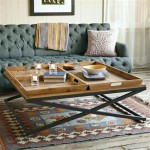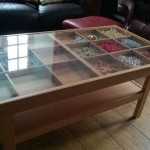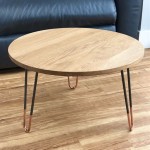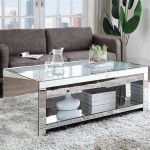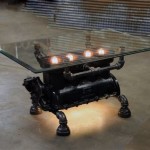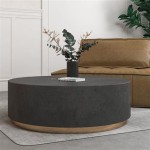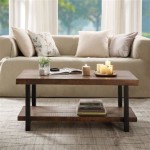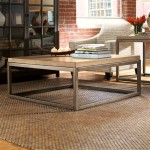What is a Good Size for a Round Coffee Table?
Selecting the correct size for a round coffee table is a crucial aspect of interior design, significantly impacting the functionality and aesthetics of a living space. The optimal dimensions depend primarily on the size of the seating area, the overall room dimensions, and the intended use of the table. A poorly sized coffee table can disrupt the flow of the room, create discomfort for users, or simply look out of place. Therefore, careful consideration of these factors is essential to ensure a harmonious and practical design.
Numerous variables influence the determination of the ideal round coffee table size. These include the number of seats in the seating arrangement, the shape and size of the sofa or sectional, the distance between the seating and the table, and the presence of other furniture pieces in the vicinity. A clear understanding of these factors is necessary to make an informed decision that complements the existing décor and enhances the usability of the space. Failure to address these elements can result in a coffee table that is either too large and imposing or too small and inadequate for its intended purpose.
This article will delve into the key considerations for choosing the right dimensions for a round coffee table, providing guidelines and practical advice to help readers make an informed decision and select a coffee table that perfectly suits their specific needs and preferences. The information provided will cover the relationship between coffee table size and sofa dimensions, the importance of spacing and accessibility, and the role of table height in achieving optimal comfort and functionality.
Relationship Between Coffee Table Size and Sofa Dimensions
The diameter of a round coffee table should be proportionate to the length of the sofa or sectional it is intended to serve. As a general guideline, the coffee table’s diameter should be roughly one-half to two-thirds the length of the sofa. This proportion helps to create a visually balanced and aesthetically pleasing arrangement. For example, if a sofa is 84 inches long, the ideal diameter for a round coffee table would be between 42 and 56 inches.
This rule of thumb ensures that the coffee table is neither dwarfed by the sofa nor overwhelming in size. A coffee table that is too small may appear insignificant and fail to provide adequate surface space for users to place drinks, books, or decorative items. Conversely, a coffee table that is too large can obstruct movement, crowd the space, and detract from the overall design aesthetic. Maintaining proper proportions is, therefore, paramount to achieving a harmonious and functional living room layout.
When dealing with multiple seating options or sectional sofas, it is important to consider the overall footprint of the seating area. In such cases, the diameter of the round coffee table should be scaled accordingly, reflecting the increased seating capacity and the need for a larger surface area. For instance, a large sectional sofa might require a round coffee table with a diameter closer to the two-thirds proportion of the sofa's length, ensuring that all seated individuals have convenient access to the table.
Furthermore, the shape of the sofa can also influence the ideal size of the round coffee table. A curved sofa, for example, might benefit from a slightly smaller coffee table diameter to avoid competing with the sofa's organic shape. Conversely, a straight-lined sofa may accommodate a larger coffee table diameter without appearing visually cluttered. The goal is to create a sense of balance and harmony between the sofa and the coffee table, ensuring that both pieces complement each other in terms of scale and design.
Ultimately, the relationship between coffee table size and sofa dimensions is a critical factor in determining the overall aesthetic appeal and functionality of the living room. By adhering to the recommended proportions and considering the specific characteristics of the seating arrangement, individuals can select a round coffee table that enhances the beauty and usability of their living space.
Importance of Spacing and Accessibility
Beyond proportional considerations, the spacing between the coffee table and the surrounding furniture is of utmost importance. Adequate spacing ensures comfortable movement around the table and easy access to seated individuals. A general recommendation is to maintain a distance of approximately 14 to 18 inches between the edge of the coffee table and the sofa or chairs. This spacing allows individuals to comfortably stretch their legs without bumping into the table and provides sufficient room to maneuver within the seating area.
Insufficient spacing can lead to a cramped and uncomfortable environment, hindering movement and creating a sense of confinement. Conversely, excessive spacing can make it difficult to reach the coffee table from the seating positions, reducing its functionality and convenience. Therefore, striking a balance between accessibility and spaciousness is crucial for optimizing the usability and comfort of the living room. The recommended 14 to 18-inch range provides a practical guideline for achieving this balance.
In addition to the distance between the coffee table and the seating, it is also important to consider the pathways around the table. Ensure that there is sufficient clearance to move freely around the coffee table without obstruction. This is particularly important in smaller living spaces where every inch counts. Creating clear pathways allows for easy access to other areas of the room and prevents the coffee table from becoming a barrier to movement.
The placement of other furniture pieces in the vicinity of the coffee table should also be taken into account. Avoid positioning the coffee table too close to other furniture, such as side tables or entertainment units, as this can create a cluttered and visually unappealing arrangement. Maintain sufficient spacing between these pieces to allow for comfortable movement and prevent the room from feeling overcrowded. The goal is to create a cohesive and balanced design that promotes a sense of spaciousness and tranquility.
The location of doorways and windows should also be considered when determining the placement and size of the round coffee table. Avoid obstructing doorways or windows with the coffee table, as this can hinder access and block natural light. Position the coffee table in a way that allows for unobstructed views and easy passage throughout the room. By carefully considering the spacing and accessibility factors, individuals can create a living room layout that is both functional and aesthetically pleasing.
Role of Table Height in Achieving Optimal Comfort and Functionality
The height of a round coffee table is just as important as its diameter. A coffee table that is too high or too low can be uncomfortable to use and can detract from the overall aesthetic appeal of the room. Ideally, the height of the coffee table should be approximately the same height as the seat cushions of the sofa or chairs. This height allows for easy access to the table and provides a comfortable surface for placing drinks, books, or other items.
As a general guideline, a coffee table height between 16 and 18 inches is considered standard and works well with most sofas and chairs. However, the specific height may need to be adjusted depending on the height of the seating. For example, if the sofa has particularly high seat cushions, a slightly taller coffee table may be required to maintain proper proportions and ensure comfortable use. Conversely, if the seating is lower to the ground, a shorter coffee table may be more appropriate.
In addition to the height of the seating, the intended use of the coffee table should also be considered when determining its height. If the coffee table is primarily intended for decorative purposes, a slightly lower height may be acceptable. However, if the coffee table is frequently used for eating or working, a taller height may be more comfortable and practical. The goal is to select a coffee table height that meets the specific needs and preferences of the users.
The style of the coffee table can also influence its height. For example, a modern or minimalist coffee table may have a lower profile, while a traditional or ornate coffee table may be taller. Consider the overall design aesthetic of the room and choose a coffee table height that complements the existing décor. The height of the coffee table should contribute to the overall visual harmony of the space and enhance the comfort and functionality of the seating area.
Ultimately, the role of table height in achieving optimal comfort and functionality cannot be overstated. By carefully considering the height of the seating, the intended use of the table, and the overall design aesthetic of the room, individuals can select a round coffee table that perfectly complements their living space and enhances its usability and comfort. Paying close attention to this detail will ensure that the coffee table serves its intended purpose effectively and contributes to the overall aesthetic appeal of the room.

What Are The Standard Coffee Table Dimensions For You Living Room

Caleb Ceramic Round Coffee Table Scandesigns Furniture

Round 2 Coffee Table Made Of Metal Cm ø60x36h

Convenience Concepts Royal Crest 2 Tier Acrylic Glass Coffee Table

Ottoman And Coffee Table Size Measurements For Your Space Poly Bark

How To Choose The Right Size Shape Coffee Table For Your Living Space

The Ultimate Guide To Pick Coffee Table Sizes And Shapes

Xiomara 48 Coffee Table Natural Sand Striae West Elm

Homall 35 Round Coffee Table Solid Wood End With Rustic St

Lc Coffee Tables Set Ibfor Your Design
Related Posts

